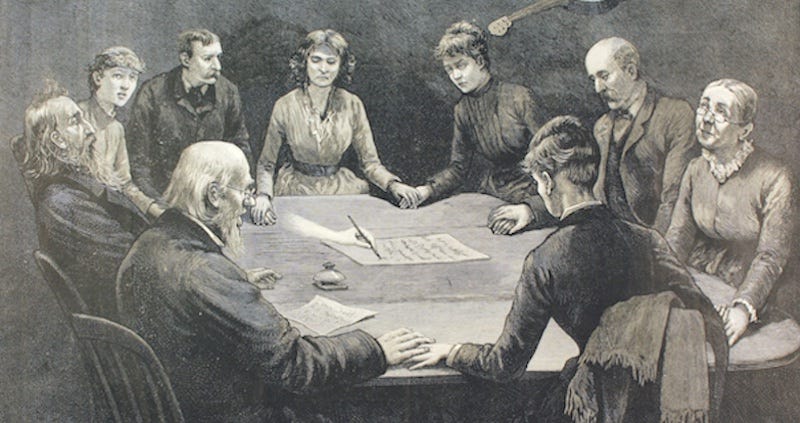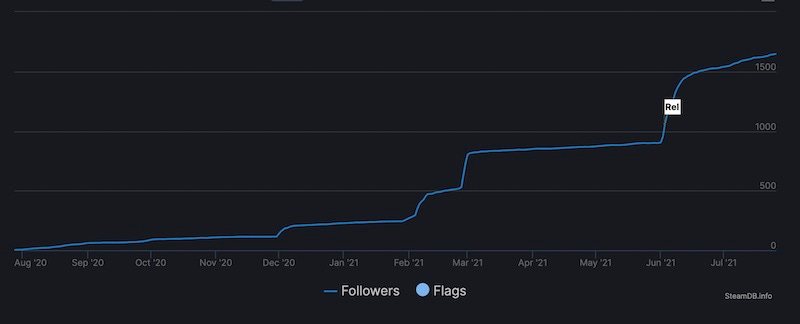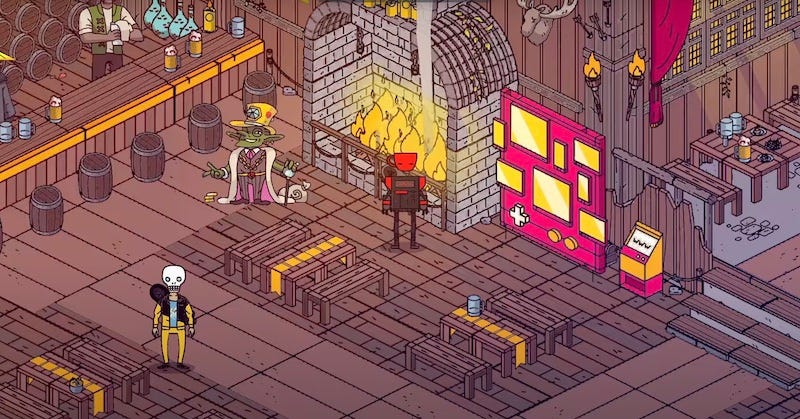
Featured Blog | This community-written post highlights the best of what the game industry has to offer. Read more like it on the Game Developer Blogs or learn how to Submit Your Own Blog Post
When Steam wishlists don't convert: a case study
Working out how your game is going to sell at launch - even if you’ve accumulated a lot of apparent interest and Steam wishlists - can feel like communing with the great beyond. We get into it.

[The GameDiscoverCo game discovery newsletter is written by ‘how people find your game’ expert & GameDiscoverCo founder Simon Carless, and is a regular look at how people discover and buy video games in the 2020s.]
Welcome to another week on the game discovery treadmill, folks. Thanks for all the kind comments about the newsletter recently, too. Myself and my colleagues on the code and data-compiling side of things really do this because we care about getting better outcomes for you and your games.
And if we can help even a small percentage of you do that, it’s a good use of our time. Also, all this deep thinking is fun! So let’s get to it…
[HEADS UP: to keep supporting us and get our ‘Complete Game Discovery Toolkit’ eBook, sign up for GameDiscoverCo Plus now- only $12-ish/month if you get a year, includes tag browsing/rankings for unreleased Steam games, private/cool Discord access, and lots more.]
Divining wishlist conversions: scrying the portents

So I’m starting this newsletter with a picture of a Victorian seance. Why? Well, working out how your game is going to sell at launch - even if you’ve accumulated a lot of apparent interest and Steam wishlists - can feel like communing with the great beyond. (Look, the disembodied hand is writing out your Week 1 wishlist/sales ratio!)
We’re reminded of this because the developer of space combat 2D action roguelike Power Of Ten made a Reddit post recently titled ‘My wishlist[s] just didn’t show up’, in which he explains: “On June 3rd I launched my game into Early Access with about 12k wishlists, which I was ecstatic about… My game was on Popular Upcoming for about 2-3 days leading up to launch. I had about 10k wishlists at the start of that run-up. I also had an Imgur post go viral with around 70k views and 1200 upvotes the night before launch.”
But the results? Not so happy: “Launch day my wishlist converted at 1.9%. Only 900 people even clicked through the notification email and I had roughly 300 sales at the end of the day. I was devastated, to be honest.” As of now, the game has 29 Positive Steam reviews - so probably around 1,000-1,500 sales.
Luckily, the dev (AJRDesign) had a dayjob, so his finances are just fine. But he goes on to self-diagnose exactly what I think the issue was with his expectations:
He admits: “I put out the Steam page around September last year. It stumbled along for a while, getting 3-4 wishlists a day.” I’ve talked about this quite a bit, but natural interest in the game when not much is going on - as long as you’ve properly announced it - can be a key indicator of final results.
He had intermittent wishlist spikes, sure: “Occasionally someone would do a youtube video of the demo, or I’d make a post with modest traction on Reddit and it’d get to 30-40 a day for a few days.” And he did get a Splattercat video (see above) which got the game a few hundred more wishlists.
But the vast majority of his wishlists for Power Of Ten were via his Steam Festival appearance in February: “I was getting 600-900 wishlists per day. I was frequently on the main festival page, hundreds of people played the demo. This got me to about 7-8k wishlists.”
So as a percentage, the wishlists got via ‘special features’ is high - 80% or more. And the dev now believes: “The vast majority of those wishlists that I got through the Festival and Steam’s build up to launch were worthless and likely will never buy the game. I have heard from several folks that they played the demo during the festival and bought the game because of it, but I think those are honestly the exception not the rule.”
To some extent, we’ve discussed this before. But I wanted to show the Power Of Ten follower graph on SteamDB and talk about how I interpret it. Here it is:

So, I have a new mantra with follower graphs on SteamDB - ‘RIGHT ANGLES MEAN INORGANIC WISHLISTS’. If you can see a very sharp angle in the graph at any given point, it means there has been a sudden follower (& wishlist) boost that returns swiftly to normal. And most sudden boosts that disappear are Steam-related internal ‘sales’ or demo showcases that can have dubious quality wishlists. (Not saying don’t do ‘em, though! They may be ‘buy at 50% off’ wishlists, who knows? Just bear their effect in mind.)
If you’d like to see a Utopian curve for a Steam game that I think it going to do great, here’s the (relatively young) follower graph for Free Lives & Devolver’s ‘reverse city builder’ Terra Nil:

Obviously it has lots more followers - so it’s somewhat cheating to say it’ll do well. But you can also see its inflection points are padded out with ‘natural’ interest in the underlying graph. There’s no sharp jerks upwards from flat line to near-vertical ascent and back.
I’m not sure whether Steam follower graph interpretation is science, art or the discovery equivalent of being a water witch in a drought. But I take followers (and wishlists) seriously as an indicator of pre-release interest. And while your game can still take off at launch or even after - generally via streamer pickup - it’s the exception, rather than the rule. Feel free to join my ‘communing with the future’ via graphs.
Finally: I don’t think this is the end of the story for Power Of Ten. As a roguelite space exploration title, its aesthetics are on the indie side, and it perhaps lacks hook besides the roguelite x exploration angle. But it’s clearly a good game. It didn’t fail on expectation management, and has great reviews and a committed community who are wondering why more people aren’t discovering it.
But most of all, it’s an Early Access release. And as one Reddit thread commenter notes: “So, I played your demo, thought it looked promising with a nice aesthetic, and wishlisted the game. I saw the release email last week but didn't click the link because it's Early Access and I prefer to play a finished game.”
We already know that Early Access launches often do 50% of the units of ‘full’ launches if you compare the first few days on sale, with many players waiting. And we’ve covered other more arcade-y topdown space roguelites that did great like Nova Drift. So perhaps Power Of Ten could still shine, sales-wise over time! And good luck to ‘em.
Regional interest: how about Nintendo Switch?

One question somebody had for us after that recent newsletter about regional appeal for your game, which was largely Steam-centric: how about consoles like the Switch? Can you work out what regions are most interested in your game before release there?
So yep, consoles are very different to PC because they have a different hardware installed base footprint. And there’s very little console pre-release info I’m aware of which would indicate regional interest for your game. But we do know where the actual Switch hardware is available! And that’s a big hint.
Specifically, looking at the latest Nintendo results (.PDF link), lifetime Nintendo Switch hardware sales are as follows: Japan - 20,040,000; The Americas - 33,270,000; Europe - 21,580,000; Other - 9,710,000. (I’m a little surprised the Americas are so far ahead of Europe.)
And, after talking to multiple folks releasing Nintendo Switch games, it looks like the United States, England, France, and Germany (A tier) - plus Australia and Canada (B+ tier) are generally the highest ranked sales on a country basis for your Switch games, based on real post-launch data. (Plus there’s Japan if you publish in that territory, and have a relevant game.)
To some large extent, sales are just an indication of where Switch hardware is most often played, based on population and interest. You do still sometimes get regional spikes based on specific game content, though. (For example, Descenders is big in Germany - in general - because mountain biking is very popular in Germany!) But YMMV, and tell me if you disagree.
The game discovery news round-up..

Nearly sorta done. But it’s time to poke around in the tea-leaves, and continue examining the Internet for signs and portents on interesting game discovery and platform gubbins, my lovelies.
And for some reason, I’m listening to acid jazz today, so if I start wearing a giant hat and cavorting around, you’ll know why, oh no. OK, links:
The queen of socials, Victoria Tran has put up an amazingly good article on Among Us’ TikTok learnings. It’s super thoughtful on the privilege of working on Among Us, while still comparing TikTok results objectively and fairly. Love it. Also she points out Jacob Janerka’s game-themed TikToks are blowing up, which I meant to mention the other week, and is very cool.
So, that ‘put all the descriptive names in your Steam game name’ semi-exploit we mentioned last week? Valve was right on that, renaming even longer-standing examples like Ranch Simulator and providing feedback to devs that “the ‘game name’ section is meant to be for your registered name only… please consider this message a warning and do not attempt to add any extraneous information [anywhere on store page] to manipulate the search results.” So that showed them!
Really recommend you all read this interview with Mark Zuckerberg about ‘the metaverse’ and how his Facebook and Oculus visions mesh together long-term: “If we do this well, I think over the next five years or so, in this next chapter of our company, I think we will effectively transition from people seeing us as primarily being a social media company to being a metaverse company.” Not sure if I buy it, but I think larger platforms own the future. And if I were a FAAMG company, I would be extensively spending to get ahead of potential paradigm shifts, particularly the ‘start using AR glasses instead of a smartphone’ transition.
Just kicking off online and with a Steam sale for its games: DreamHack Beyond. This is interesting since it uses an extended version of the Indie Arena Booth tech (trailer, pictured above) for its ‘online consumer game fest’ interface. Still not sure this is precisely what people want from online events - I like Skittish’s attemps to get playful with social interaction in this space. But it’s necessary innovation as the pandemic continues to rage.
Microlinks: Google Stadia announced its Crowd Play feature, which “allows your friends and viewers to jump into the game and play alongside you as you stream” and is SUPER cool; Facebook now forced to use a web browser-based ‘workaround’ app on iOS for its Facebook Gaming cloud games, like Amazon and Xbox; we dig some of the graphical tricks used for the EA Play Steam ‘sale/recap’ page, like using alpha-ed video subtly behind the game’s key art.
Intriguingly, Microsoft announced that “we've made the Microsoft Game Development Kit available on GitHub, free of charge!… The GDK is the same base development kit used by hundreds of game creators today and was previously only available to approved partners building for the Xbox ecosystem.” But it’s actually binaries, not source, and as Gamasutra notes, “access to publish on the Xbox ecosystem will remain private, and that anybody looking to launch a game on Xbox or Windows PC will still need to apply and qualify for the Xbox Developer Program.” So maybe this is more of a… top of funnel type thing? Nonetheless…
Microlinks, Pt. 2: great to see the winners of the Game Makers Sketchbook contest, for quality drawn, rendered, and icon-ed game art; a detailed blog on pitching your game with some edgy opinions (“no one cares about the story of your game”); micro-indies like Draknek are doing ‘Draknek Direct’ multi-game video presentations, and we’re here for it.
Finally, I was super happy to see the wonderful YouTube channel People Make Games (here’s their Patreon), which has previously covered crunch in game outsourcing and the Neopets x Scientology connection, come up a new video on the Halfbrick (Fruit Ninja) prototype that had to be banned from internal use (!) a few years back.
It was a game called ‘Tank Tactics’. Halfbrick’s Luke Muscat (nowadays helping mastermind Snap’s video games) discussed it for a GDC 2016 talk, but talked about it again for PMG. I dig the video for bringing up all kinds of complex questions about how real life and games interact, how much time you SHOULD be spending on them, and, uhh, how addictive is too addictive? Behold:
[We’re GameDiscoverCo, a new agency based around one simple issue: how do players find, buy and enjoy your premium PC or console game? You can subscribe to GameDiscoverCo Plus to get access to an exclusive eBook, extra weekly newsletters, interactive daily rankings of every unreleased Steam game, and lots more besides.]
Read more about:
Featured BlogsAbout the Author(s)
You May Also Like







.jpeg?width=700&auto=webp&quality=80&disable=upscale)








